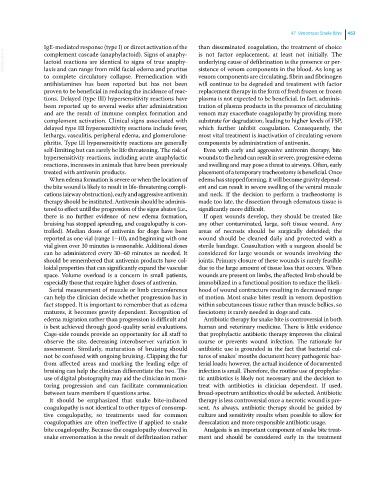Page 495 - Clinical Small Animal Internal Medicine
P. 495
47 Venomous Snake Bites 463
IgE‐mediated response (type I) or direct activation of the than disseminated coagulation, the treatment of choice
VetBooks.ir complement cascade (anaphylactoid). Signs of anaphy- is not factor replacement, at least not initially. The
underlying cause of defibrination is the presence or per-
lactoid reactions are identical to signs of true anaphy-
laxis and can range from mild facial edema and pruritus
venom components are circulating, fibrin and fibrinogen
to complete circulatory collapse. Premedication with sistence of venom components in the blood. As long as
antihistamines has been reported but has not been will continue to be degraded and treatment with factor
proven to be beneficial in reducing the incidence of reac- replacement therapy in the form of fresh frozen or frozen
tions. Delayed (type III) hypersensitivity reactions have plasma is not expected to be beneficial. In fact, adminis-
been reported up to several weeks after administration tration of plasma products in the presence of circulating
and are the result of immune complex formation and venom may exacerbate coagulopathy by providing more
complement activation. Clinical signs associated with substrate for degradation, leading to higher levels of FSP,
delayed type III hypersensitivity reactions include fever, which further inhibit coagulation. Consequently, the
lethargy, vasculitis, peripheral edema, and glomerulone- most vital treatment is inactivation of circulating venom
phritis. Type III hypersensitivity reactions are generally components by administration of antivenin.
self‐limiting but can rarely be life threatening. The risk of Even with early and aggressive antivenin therapy, bite
hypersensitivity reactions, including acute anaphylactic wounds to the head can result in severe, progressive edema
reactions, increases in animals that have been previously and swelling and may pose a threat to airways. Often, early
treated with antivenin products. placement of a temporary tracheostomy is beneficial. Once
When edema formation is severe or when the location of edema has stopped forming, it will become gravity depend-
the bite wound is likely to result in life‐threatening compli- ent and can result in severe swelling of the ventral muzzle
cations (airway obstruction), early and aggressive antivenin and neck. If the decision to perform a tracheostomy is
therapy should be instituted. Antivenin should be adminis- made too late, the dissection through edematous tissue is
tered to effect until the progression of the signs abates (i.e., significantly more difficult.
there is no further evidence of new edema formation, If open wounds develop, they should be treated like
bruising has stopped spreading, and coagulopathy is con- any other contaminated, large, soft tissue wound. Any
trolled). Median doses of antivenin for dogs have been areas of necrosis should be surgically debrided; the
reported as one vial (range 1–10), and beginning with one wound should be cleaned daily and protected with a
vial given over 30 minutes is reasonable. Additional doses sterile bandage. Consultation with a surgeon should be
can be administered every 30–60 minutes as needed. It considered for large wounds or wounds involving the
should be remembered that antivenin products have col- joints. Primary closure of these wounds is rarely feasible
loidal properties that can significantly expand the vascular due to the large amount of tissue loss that occurs. When
space. Volume overload is a concern in small patients, wounds are present on limbs, the affected limb should be
especially those that require higher doses of antivenin. immobilized in a functional position to reduce the likeli-
Serial measurement of muzzle or limb circumference hood of wound contracture resulting in decreased range
can help the clinician decide whether progression has in of motion. Most snake bites result in venom deposition
fact stopped. It is important to remember that as edema within subcutaneous tissue rather than muscle bellies, so
matures, it becomes gravity dependent. Recognition of fasciotomy is rarely needed in dogs and cats.
edema migration rather than progression is difficult and Antibiotic therapy for snake bite is controversial in both
is best achieved through good‐quality serial evaluations. human and veterinary medicine. There is little evidence
Cage‐side rounds provide an opportunity for all staff to that prophylactic antibiotic therapy improves the clinical
observe the site, decreasing interobserver variation in course or prevents wound infection. The rationale for
assessment. Similarly, maturation of bruising should antibiotic use is grounded in the fact that bacterial cul-
not be confused with ongoing bruising. Clipping the fur tures of snakes’ mouths document heavy pathogenic bac-
from affected areas and marking the leading edge of terial loads; however, the actual incidence of documented
bruising can help the clinician differentiate the two. The infection is small. Therefore, the routine use of prophylac-
use of digital photography may aid the clinician in moni- tic antibiotics is likely not necessary and the decision to
toring progression and can facilitate communication treat with antibiotics is clinician dependent. If used,
between team members if questions arise. broad‐spectrum antibiotics should be selected. Antibiotic
It should be emphasized that snake bite‐induced therapy is less controversial once a necrotic wound is pre-
coagulopathy is not identical to other types of consump- sent. As always, antibiotic therapy should be guided by
tive coagulopathy, so treatments used for common culture and sensitivity results when possible to allow for
coagulopathies are often ineffective if applied to snake deescalation and more responsible antibiotic usage.
bite coagulopathy. Because the coagulopathy observed in Analgesia is an important component of snake bite treat-
snake envenomation is the result of defibrination rather ment and should be considered early in the treatment

